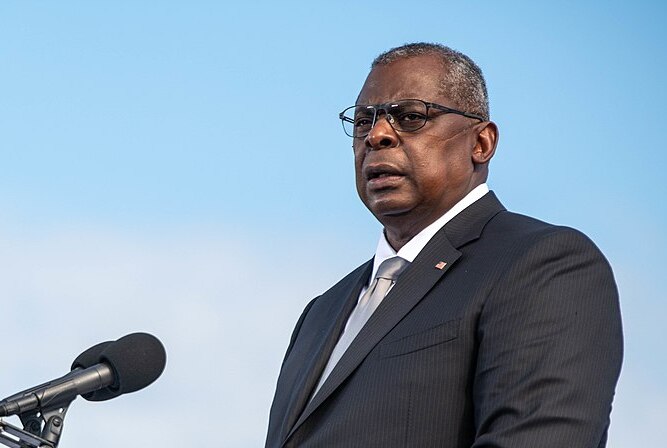US Secretary of Defence Lloyd J. Austin III was in the island kingdom of Bahrain over the weekend where he, as the New York Times succinctly put it, “faced tough questions about how Arab allies were supposed to deal with the whiplash of an American national security policy that upends itself every four to eight years with a new president.”
The Gulf Arab states have long dreaded the prospect of Iran developing nuclear weapons and worry about Tehran’s various militia proxies across the region. Until recently, most of them took a hardline stance against Iran and its policies in the region, confident that they could do so while safe under the protective umbrella of the US military. Now they have less confidence in American support and if the US will even retain its military presence in the Middle East. Several leading Gulf countries have already approached Tehran for bilateral negotiations to reduce tensions in the region, at least partially out of recognition that US military might not be there forever.
The rapidly declining confidence in American staying power in the Middle East began late in the Trump administration. It continued after Biden entered office and pulled the last US troops out of Afghanistan, leading to an immediate Taliban takeover of that country. As Washington focuses more on being ready to deal with an ascendant China, its allies in the Middle East worry it will become much less interested in their region or even conclude that its military presence there is a strategic liability.
Iraq is a country that could find itself in even more serious dire straits if the US completely withdraws. The administration stresses that it has no plans to leave Iraq like it did Afghanistan, invariably arguing that they are two very different and distinct cases. But how can Iraqis, and Iraqi Kurds, be so sure of such verbal guarantees of American commitment?
Over the summer, the US agreed to end its combat mission against the Islamic State (ISIS) in Iraq by December 31, 2021. After that date, the modest 2,500 US troops in that country will play a strictly advisory role and help train Iraqi and Kurdish security forces. It will only use force in self-defence.
Powerful, well-armed Iraqi Shiite militias backed by Iran oppose any US presence in the country. Also, ISIS remains an active threat to that country and its people.
The US previously withdrew all of its troops from Iraq a decade ago, December 2011, at the end of the chaotic Iraq War. Most Americans almost instantly put Iraq in the rearview mirror after that disastrous and costly conflict. However, the US was sucked back into the country after the bloody rise of ISIS in mid-2014 threatened Iraq’s very existence. America re-intervened under an administration that had sought to end the US military’s engagement in that country and instead focus on winning the so-called “good war” in Afghanistan (how times have changed!).
Now another full US withdrawal could have similarly chaotic implications for Iraq almost a decade after the last one. Militias could exploit a predictable political and security vacuum that such a withdrawal will create and amass more power at the state’s expense. ISIS could even make a resurgence.
Retaining that modest force of advisory troops is certainly a lot better than nothing since the Iraqi Security Forces (ISF) and the Kurdish Peshmerga still need a substantive amount of support and training if they are going to be able to cope with the numerous potential threats they could well face in the near future.
And they’ll need all the help they can get.
The latest US Department of Defence’s Office of the Inspector General, released in early November, was its most scathing criticism of the ISF in some time. The report warned that the army “continued to face challenges from corruption at every level” and that its effectiveness continues to be hampered by personal vendettas and infighting between the ministries of defence and interior. The Iraqi Army infamously withdrew from the north of the country without a fight during ISIS’s takeover of Mosul, Iraq’s second city, in June 2014. Their failure to put up a fight was the ultimate result of rampant corruption and the sectarian policies of former Iraqi Prime Minister Nouri al-Maliki. That army could similarly fail today if these current deficiencies aren’t addressed with the help of the US and the US-led coalition against ISIS.
The Kurdish Peshmerga, who valiantly held the line in the north against ISIS for years, is also undergoing some much-needed reforms. The two main brigades of that Kurdish force, which consists of the vast majority of Peshmerga, are separately commanded by the two main political parties in that autonomous region. Gradually they are being unified under the non-partisan Ministry of Peshmerga with help from the US-led coalition, but that will take considerable time and effort.
A modest American presence, with help from other coalition member states and NATO, focused on training and reforming Iraqi and Kurdish forces could go a long way to preventing Iraq from once again being engulfed by yet another destabilizing war.
However, the fears of the Gulf Arabs, Iraqis and Kurds about a potential American drawdown from the region are far from unfounded. One cannot completely rule out that the next administration in Washington will be another Trump presidency or some other wildcard who could take a completely different approach and leave these allies to fend for themselves.
With that possibility in mind, they should get the most out of America’s presence in the region – especially in terms of improving, reforming, and training their armed forces – while it lasts.

